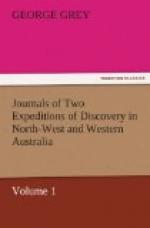At 6 A.M. the thermometer stood at 76 degrees Fahrenheit in the shade, and this and the temperature during our stay in Shark Bay proves that the climate there is very warm. Before breakfast I had wells sunk in several places at some little distance inland in order to ascertain the nature of the subsoil, for we were abundantly supplied with water from the lagoons. In every instance, after digging down to the depth of from six to seven feet through a rich loam, we reached a regular sandy sea beach and salt water (it must however be recollected that we dug in the deepest hollows) so that it appeared as if the whole of this flat country was a formation left upon the shoals with which the coast is bounded; and it almost seemed as if the sea still flowed in upon its old bed and under this recent freshwater deposit.
Directly after breakfast I got ferried across the river to the island lying between its two mouths, which I called Babbage Island after C. Babbage, Esquire. This island is low and sandy in all parts except where it fronts the sea; but on that side a row of high sandy dunes have been thrown up. There is no very good land on it, it being almost covered with samphire swamps and intersected by deep channels into which the sea runs; these are nearly concealed in some places by the vegetation, which rendered it impossible to avoid sundry falls and wettings in crossing it. It bears a few mangroves but I saw no other trees.
The men throughout the day were occupied in watering and in making canvas cloths for my boats to prevent the water from pouring in over the gunwales, which were very low; and my own time was sufficiently occupied in surveying. On my return in the evening I found Mr. Smith so much wore cheerful and so much better that I determined to start about noon the next day for the northward.
EXCURSION TO THE NORTH OF THE RIVER.
March 7.
I went off with a party before dawn to explore the country to the northward of the Gascoyne. We crossed the river just above the point where it separates into two mouths, and then struck off in a north by east direction. Travelling about a mile after we had crossed the river we came to seven native huts, built of large-sized logs, much higher and altogether of a very superior description to those made by the natives on the south-western coast. Kaiber examined them very carefully and then proposed that we should go no farther, as he thought that the natives must be very large men from their having such large huts. We however pushed forward and, as I had none but good walkers with me, we made about nine miles in two hours and a half: throughout the whole of this distance we saw nothing that could be called a hill, the whole country being evidently at times flooded up to the foot of a gently-rising land which we distinguished to the eastward. We did not notice a single tree but plenty of low prickly bushes, samphire, and a small plant somewhat resembling the English heath. The weather was very hot, and at the end of the nine miles we reached a saltwater inlet so broad and deep that we could not cross it. We here halted and rested a little and then made our way back to the boats.




